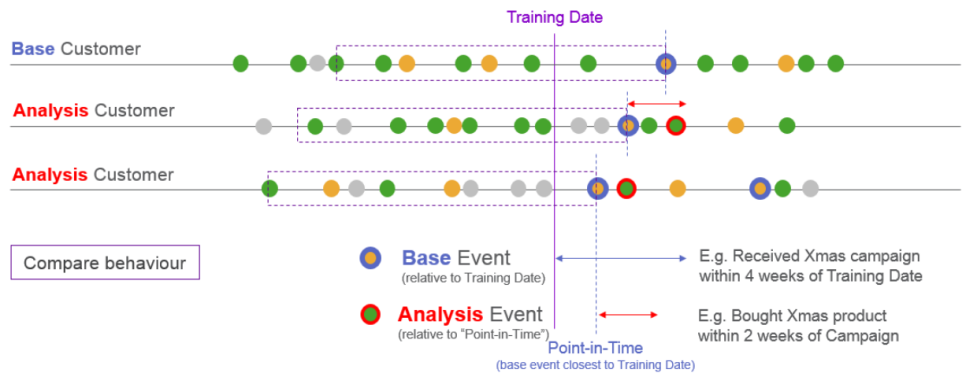Behavioural modelling - fixed and event driven point-in-time
As an alternative to creating fixed point behaviour based models, i.e. where all individuals are analysed based on the same time point, Behavioural Modelling in FastStats also supports analysing behaviour up to a point-in-time which varies on a person by person level, depending on when some event has happened to each individual - i.e. event driven point-in-time.
You can use event driven behavioural modelling within the Modelling Environment to take underlying transaction level selections and, from these, define both simple and more detailed customer journey selections.
An example of such an event might be when a person received a marketing communication.
Models can be built on which individuals have a subsequent event - for example, they responded by making a purchase.
This allows you to focus your analysis on the time frame that is relevant to each individual and examine, for example, what people were doing in the time leading up to a campaign which may have led them to respond by making a significant purchase. An alternative use might be to examine the behaviour of lapsed customers in the period leading up to them lapsing.

The above diagram demonstrates the principle of fixed point modelling, whilst the following diagram demonstrates how event driven point-in-time analysis works to align each customer's timeline so that the behavioural features are all generated based on a time frame that is driven by when the event occurred for each individual:

Definition of the "point-in-time"
The point-in-time is the date relative to which you are studying behaviour. It might refer to the fixed date or the date of a base event booking. This is used to specify when the analysis event must occur, and is also used in modelling when creating features such as the “count of bookings before the point -in-time”.
Fixed is ideal when you want to study all people as of a specific date - for example, for a Christmas campaign.
Event driven is required when each record has a different start date for the behaviours you want to explore - for example, a specific donation or transaction.
Where multiple base events have occurred within the time frame, it is the date of the event closest to the training date which determines the point-in-time. The point-in-time is a recency aggregation selecting the closest base event to the training date.
For more information on customer journey analysis, see Customer journeys - analysis and base selections
For related topics see Behavioural modelling - setting up the environment